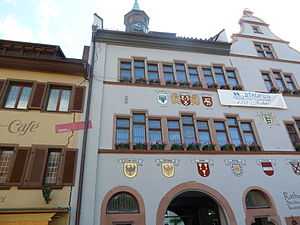Staufen im Breisgau
| Staufen im Breisgau | ||
|---|---|---|
 | ||
| ||
 Staufen im Breisgau | ||
Location of Staufen im Breisgau within Breisgau-Hochschwarzwald district 
 | ||
| Coordinates: 47°52′53″N 7°43′53″E / 47.88139°N 7.73139°ECoordinates: 47°52′53″N 7°43′53″E / 47.88139°N 7.73139°E | ||
| Country | Germany | |
| State | Baden-Württemberg | |
| Admin. region | Freiburg | |
| District | Breisgau-Hochschwarzwald | |
| Subdivisions | 3 | |
| Government | ||
| • Mayor | Michael Benitz | |
| Area | ||
| • Total | 23.26 km2 (8.98 sq mi) | |
| Elevation | 284 m (932 ft) | |
| Population (2012-12-31)[1] | ||
| • Total | 7,490 | |
| • Density | 320/km2 (830/sq mi) | |
| Time zone | CET/CEST (UTC+1/+2) | |
| Postal codes | 79219 | |
| Dialling codes | 07633 | |
| Vehicle registration | FR | |
| Website | www.staufen.de | |
Staufen im Breisgau is a German town in the Breisgau-Hochschwarzwald district of Baden-Württemberg. It has a population of approximately 7,800 inhabitants.
General
The city of Staufen im Breisgau lies in the Land district of Breisgau-Hochschwarzwald (Breisgau-Upper Black Forest) in the German State of Baden-Württemberg. The City of Staufen has approximately 7700 inhabitants and forms, together with the community of Münstertal, Black Forest, a community administrative unit.[2]
It is noted in history and culture for its association with Dr Faustus who, according to legend, sold his soul to the Devil at an inn here.
Geography
Staufen lies at the foot of the Black Forest at the exit from the Münstertal. The Black Forest valley of Neumagen goes here directly over into the Rhine plain. The piedmont of the Black Forest is less distinct. North of the valley exit, the steeply rising Schlossberg dominates; to the southwest begins the hilly landscape of the Markgräflerland. Staufen lies on the border between two natural and economic areas: the Rhine plain up to the piedmont with its cultivation of grain, winegrapes and vegetables; and the Black Forest, with its cattle and forestries, and, in an earlier time, mining.[2]
Geothermal drilling controversy

Since 2008, the centre of the city has reported to have risen some 12 cm,[3] after initially sinking a few millimeters.[4] This has caused considerable damage to buildings in the city centre, including the historical town hall. One hypothesis for the cause of this geological change is a drilling operation conducted in the spring of 2007 to provide geothermal heating to the city hall. The drilling perforated an anhydrite layer and caused high-pressure groundwater to come into contact with the anhydrite, which then began to expand. In July 2013,[5] no end to the rising process was in sight.[6][7][8] By 2010, some sections of town had risen by 30 cm.[9]
Data from the TerraSAR-X radar satellite before and after the changes have confirmed the localised nature of the situation. "A geochemical process called anhydrite swelling has been confirmed as the cause of these uplifts. This is a transformation of the mineral anhydrite (anhydrous calcium sulphate) into gypsum (hydrous calcium sulphate). A pre-condition for this transformation is that the anhydrite is in contact with water, which is then stored in its crystalline structure".[10]
References
- ↑ [Statistisches Bundesamt – Gemeinden in Deutschland mit Bevölkerung am 31.12.2012 (XLS-Datei; 4,0 MB) (Einwohnerzahlen auf Grundlage des Zensus 2011) "Gemeinden in Deutschland mit Bevölkerung am 31.12.2012"]. Statistisches Bundesamt (in German). 12 November 2013.
- ↑ 2.0 2.1 de:Staufen im Breisgau
- ↑ Spiegel.de report on recent geological changes (in German, partial translation)
- ↑ The Telegraph: Geothermal probe sinks German city (31 March 2008)
- ↑ badische-zeitung.de, Kein Ende der Hebungen in Staufen in Sicht (13. July 2013)
- ↑ FORMACIJE, A (2010). "DAMAGE TO THE HISTORIC TOWN OF STAUFEN (GERMANy) CAUSED By GEOTHERMAL DRILLINGS THROUGH ANHyDRITE-BEARING FORMATIONS". Acta Carsologica 39 (2): 233.
- ↑ Butscher, Christoph; Huggenberger, Peter; Auckenthaler, Adrian; Bänninger, Dominik (2010). "Risikoorientierte Bewilligung von Erdwärmesonden". Grundwasser 16: 13–24. doi:10.1007/s00767-010-0154-5.
- ↑ Goldscheider, Nico; Bechtel, Timothy D. (2009). "Editors' message: The housing crisis from underground—damage to a historic town by geothermal drillings through anhydrite, Staufen, Germany". Hydrogeology Journal 17 (3): 491. doi:10.1007/s10040-009-0458-7.
- ↑ badische-zeitung.de, Lokales, Breisgau, 15. Oktober 2010, hcw: Keine Entwarnung in der Fauststadt - Risse in Staufen: Pumpen, reparieren und hoffen (17. Oktober 2010)
- ↑ TerraSAR-X Image Of The Month: Ground Uplift Under Staufen's Old Town, TerraSAR-X radar satellite, [www.spacemart.com],2009-10-22 , accessed 2009-10-23
External links
- Official website
- (German) Staufen:images
